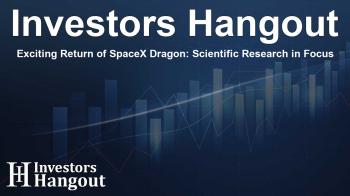Exciting Return of SpaceX Dragon: Scientific Research in Focus

SpaceX Dragon Set for Historic Departure
NASA is gearing up for the return of vital scientific research as the SpaceX Dragon spacecraft prepares to undock from the International Space Station (ISS). This significant event marks yet another collaboration between NASA and SpaceX, enhancing our understanding of science and technology aboard the ISS.
Live Coverage of the Mission
The undocking and departure of the Dragon spacecraft will be broadcasted live, providing audiences an unprecedented view of this pivotal moment. The coverage will allow viewers to witness the intricacies of space missions and the efforts involved in scientific exploration. Audiences can tune in to witness this event unfold, amplifying public interest in space research.
Operation Details of Undocking
At precisely the scheduled time, the Dragon spacecraft will undock from the zenith port of the Harmony module, expertly controlled by SpaceX's Mission Control team. This maneuver demonstrates the advanced capabilities involved in space operations, setting up the Dragon for its return to Earth.
Scientific Cargo on Board
The spacecraft carries an impressive 6,700 pounds of supplies and scientific materials that need to be returned to Earth. This cargo is crucial for a variety of experiments and hardware that will contribute to our ongoing exploration of space and enhance our knowledge base.
Exploring Materials in Space
Among the items being returned is the MISSE-20 experiment, which has been testing how various materials react to the harsh conditions of space, like radiation and extreme temperatures. These insights will inform future material development for space missions.
Innovations in Space Robotics
Astrobee-REACCH, another significant returnee, showcases the capabilities of robotic technology in space. By successfully demonstrating its ability to capture and relocate objects, it provides groundwork for future efforts to manage space debris, which is a growing concern for all space agencies.
Education and Community Engagement
The mission will also bring back educational initiatives like the Story Time from Space project, where astronauts read books to children while conducting science experiments. This not only engages young minds but also bridges a gap between education and space exploration.
Advancements in Imaging Technology
The OPTICA experiment will return hardware that has pushed the limits of our understanding of data transmission from space to Earth. This technology has potential applications in disaster response and various Earth observation fields, making it invaluable for future advancements.
Continuous Research and its Impact
The ISS has been a beacon of continuous human presence in space for over 24 years, serving as a platform for scientific research that benefits humanity. Each mission contributes to our understanding and capabilities in human spaceflight, paving the way for future explorations to the Moon and beyond.
Look Ahead to Future Missions
With aspirations set on lunar missions and eventually crewed missions to Mars under the Artemis program, the lessons learned from the ISS and the ongoing research conducted there will prove crucial. Every experiment conducted on the ISS not only assists with current technological advancements but also helps prepare us for the challenges that lie ahead in deep space exploration.
Frequently Asked Questions
What is the SpaceX Dragon mission about?
The SpaceX Dragon mission focuses on returning scientific research samples and hardware from the ISS back to Earth.
When will the Dragon spacecraft leave the ISS?
The Dragon spacecraft is scheduled to undock at a designated time, followed by its return journey to Earth.
What kind of research is being returned?
Research includes experiments on material science, robotics, educational initiatives, and advanced imaging technology.
How does the ISS contribute to future space missions?
The ISS serves as a testing ground for technologies and research that will support future missions to the Moon and Mars.
How can the public engage with NASA's space missions?
NASA offers live coverage of missions and has educational programs that connect the public with its research and exploration efforts.
About The Author
Contact Riley Hayes privately here. Or send an email with ATTN: Riley Hayes as the subject to contact@investorshangout.com.
About Investors Hangout
Investors Hangout is a leading online stock forum for financial discussion and learning, offering a wide range of free tools and resources. It draws in traders of all levels, who exchange market knowledge, investigate trading tactics, and keep an eye on industry developments in real time. Featuring financial articles, stock message boards, quotes, charts, company profiles, and live news updates. Through cooperative learning and a wealth of informational resources, it helps users from novices creating their first portfolios to experts honing their techniques. Join Investors Hangout today: https://investorshangout.com/
The content of this article is based on factual, publicly available information and does not represent legal, financial, or investment advice. Investors Hangout does not offer financial advice, and the author is not a licensed financial advisor. Consult a qualified advisor before making any financial or investment decisions based on this article. This article should not be considered advice to purchase, sell, or hold any securities or other investments. If any of the material provided here is inaccurate, please contact us for corrections.

